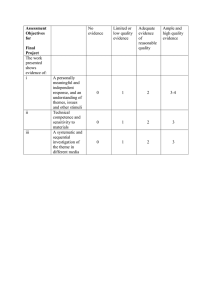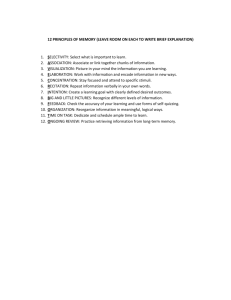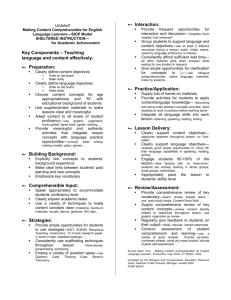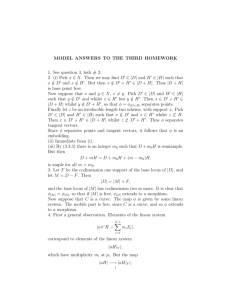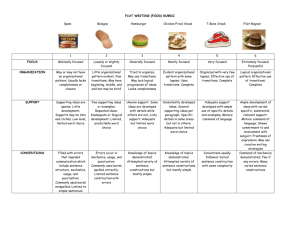A Symbolic Partial Order Reduction Algorithm for Rule Based Transition Systems Abstract
advertisement
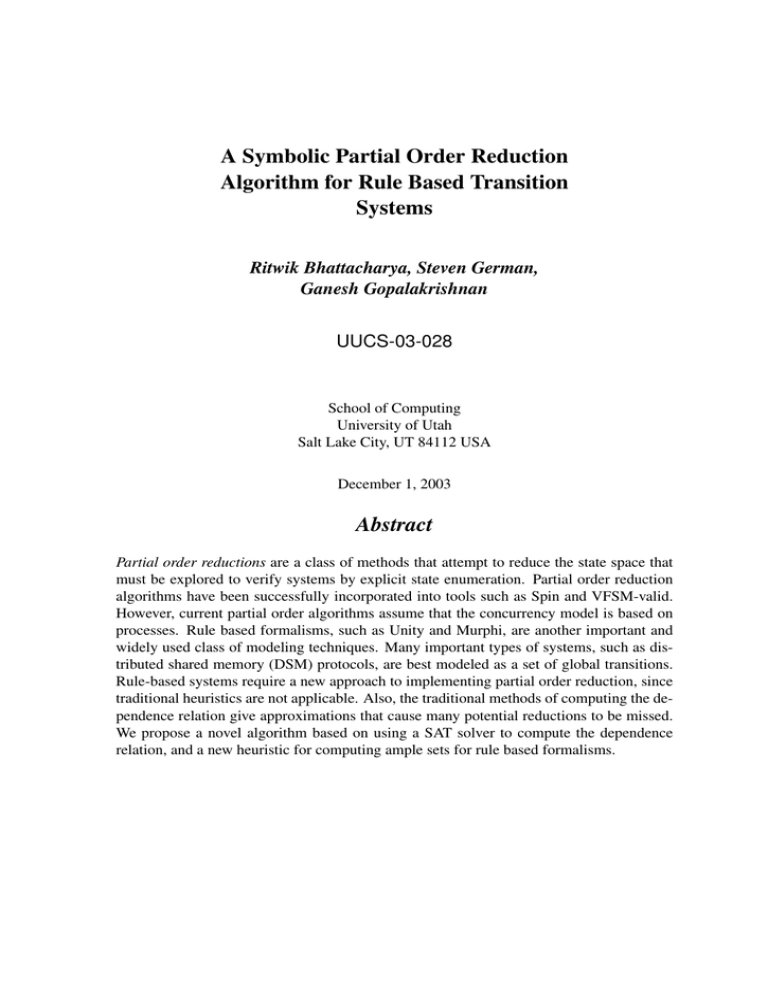
A Symbolic Partial Order Reduction
Algorithm for Rule Based Transition
Systems
Ritwik Bhattacharya, Steven German,
Ganesh Gopalakrishnan
UUCS-03-028
School of Computing
University of Utah
Salt Lake City, UT 84112 USA
December 1, 2003
Abstract
Partial order reductions are a class of methods that attempt to reduce the state space that
must be explored to verify systems by explicit state enumeration. Partial order reduction
algorithms have been successfully incorporated into tools such as Spin and VFSM-valid.
However, current partial order algorithms assume that the concurrency model is based on
processes. Rule based formalisms, such as Unity and Murphi, are another important and
widely used class of modeling techniques. Many important types of systems, such as distributed shared memory (DSM) protocols, are best modeled as a set of global transitions.
Rule-based systems require a new approach to implementing partial order reduction, since
traditional heuristics are not applicable. Also, the traditional methods of computing the dependence relation give approximations that cause many potential reductions to be missed.
We propose a novel algorithm based on using a SAT solver to compute the dependence
relation, and a new heuristic for computing ample sets for rule based formalisms.
A Symbolic Partial Order Reduction
Algorithm for Rule Based Transition
Systems?
Ritwik Bhattacharya1 , Steven German2 , and Ganesh
Gopalakrishnan1
1
School of Computing, University of Utah
{ritwik, ganesh}@cs.utah.edu
2
IBM T.J. Watson Research Center
german@watson.ibm.com
Abstract. Partial order reductions are a class of methods that attempt
to reduce the state space that must be explored to verify systems by
explicit state enumeration. Partial order reduction algorithms have been
successfully incorporated into tools such as Spin and VFSM-valid. However, current partial order algorithms assume that the concurrency model
is based on processes. Rule based formalisms, such as Unity and Murphi, are another important and widely used class of modeling techniques.
Many important types of systems, such as distributed shared memory
(DSM) protocols, are best modeled as a set of global transitions. Rulebased systems require a new approach to implementing partial order
reduction, since traditional heuristics are not applicable. Also, the traditional methods of computing the dependence relation give approximations that cause many potential reductions to be missed. We propose a
novel algorithm based on using a SAT solver to compute the dependence
relation, and a new heuristic for computing ample sets for rule based
formalisms.
1
Introduction
Partial order reduction is a technique that curbs state explosion in model
checking based on explicit state enumeration. Partial order reductions[23,7]
are based on the observation that much of the state explosion in verifying
concurrent systems stems from the interleaving of independent actions.
Partial order methods formalize the notion of redundant interleavings
and attempt to generate a subset of all the interleavings that is sufficient
to check a given property. The efficacy of partial order reductions has
been established both theoretically and in practical experiments[8]. Partial order reduction algorithms have been incorporated into tools such
as Spin[11,13] and VFSM-valid[9].
?
This work was supported in part by NSF Awards CCR-0081406 and CCR-0219805,
and SRC Contract 1031.001
Most previous work on partial order reduction deals with concurrency
models based on processes. In the process-based approach, concurrency
is modeled as the interleaving of a set of sequential processes with local
variables; the processes communicate via shared global variables and
message passing.
In many cases, verification models of complex systems do not easily fit
into the communicating process model. For example, with distributed
shared memory protocols, it is difficult to decide what constitues a process – should it be a hardware node, in which case many of its “local”
data structures have to be made globally available, or should it be a message, in which case too its buffers need to be made global. The essential
difficulty lies in the fact that a large percentage of the state variables are
truly global.
Rule-based formalisms provide a natural method for describing many
complex real systems. Indeed, languages such as Unity [2] and Murphi
[4] are widely used to model concurrency for such systems.
In this paper, we address two important problems in applying partial order reduction to complex rule-based systems. First, as mentioned above,
most previous approaches have considered process models of concurrency.
A second shortcoming of traditional partial order reduction algorithms is
their reliance on syntactic methods for computing the dependence relation. Syntactic methods use occurences of variables to determine dependence instead of solving for the possible values of variables. In order to
be sound, syntax-based dependence computation algorithms must conservatively overapproximate the dependence relation, which can result
in missing possible reductions.
The new results of this paper address both of these issues. First, we
enable reduction of rule based systems by presenting a new ample set
calculation heuristic that is applicable to rule based formalisms. Second, we develop a new symbolic dependence calculation algorithm which
uses a SAT solver. We have implemented both of these algorithms in a
new version of the Murphi verification tool called POeM – partial order
enabled Murphi – with encouraging results.
The SAT based algorithm, which is also applicable to other, non-rulebased systems, provides a more accurate characterization of the independence relation than the traditional syntactic approach, which can often
lead to greater reductions.
As an illustration of the advantage of our approach, consider the simple
Murphi system shown in 1. In the Murphi language [5], a model consists
of a set of global state variables and a set of conditional transitions.
Transitions have the form
rule ”name” guard ==> body.
A transition system is executed as follows: at each step in the execution,
select a single transition whose guard is true in the current state and
CONST
NumNodes: 2;
NumBufs : 1;
VAR
i: 0..2;
a: 0..3;
b: array [0..2] of boolean;
rule "1"
True
==>
a := (a + 1) % 4;
end;
rule "2"
True
==>
a := (a + 2) % 4;
end;
rule "3"
(i >= 0)
==>
b[i+1] := true;
end;
rule "4"
(i <= 0)
==>
b[i+2] := false;
end;
Fig. 1. Example Murphi system
then execute the statements in the body. The state reached by executing
the body is taken as the next state of the system.
A syntax-based approach would classify rules 1 and 2 as dependent on
each other, since they both update the same variable a. In the figure,
the binary operator n % 4 gives the value of its first argument mod 4.
Symbolic evaluation quickly discovers that the values of a after applying
both rules 1 and 2 in either order are identical, and hence, the SAT based
approach will rightly classify the rules as independent. Similarly, rules 3
and 4 in the figure, which both access the same array variable, would be
classified as dependent by the syntax-based approach, whereas, the SAT
based approach will find that they are independent, since they access
different indices of the array a.
Before proceeding to the details of our techniques, it is worth commenting
on the continuing practical importantance of explicit state enumeration
in model checking. Even with the recent impressive advances in BDDbased and SAT-based model-checking, a large class of systems cannot
yet be model-checked effectively using such Boolean representations. For
example, in case of BDD-based model-checking applied to the formal
verification of cache coherence protocols, the sheer number of variables,
the extensive use of high level data structures such as arrays, and the
‘all to all’ dependencies between the variables in these protocols have
resulted in BDDs exceeding current capacities [14].
Thus, there is still a great need for improving the capabilities of explicit
state enumeration model checkers. Explicit state enumeration model
checkers are also the mainstay of tools in software verification, another
important emerging area. A recent survey of industrial formal methods
[10] shows the continued widespread use of model-checkers such as Murphi and TLA in the industry.
1.1
Related Work
There has been extensive research on partial order reduction methods
(see [8] for a good survey). Few previous works address reduction for
formalisms without processes. TLC, the explicit state model checker for
TLA+ [17], is reported to have a partial order reduction algorithm [18],
but we are not aware of the details of the algorithm used. Partial order
reduction algorithms have also been proposed for symbolic state exploration methods [1]. The algorithm there is based on a modified breadth
first search, since symbolic state exploration is essentially breadth first.
The in-stack check of the traditional partial order algorithm is replaced
by a check against the set of visited states. An alternative to the traditional runtime ample set computation algorithm is discussed in [16]. The
idea is to statically compute all of the partial order reduction data, and
generate a compiled model that is already reduced, which then allows the
use of any model checking back-end for the actual verification. However,
this suffers from the same problem as other static algorithms, in that
only a limited amount of information is available at compile time.
The technique we use to transform the Murphi language (and its sequential programming constructs) into propositional logic is similar to
the well known method in which sequential programs are verified by
constructing formulas called verification conditions. The Stanford Pascal
Verifier is a representative implementation of this technique. Several recently developed tools convert C-language programs into SAT problems,
for instance, for purposes of comparing a C program and a Verilog program [15]. We are not aware of previous use of symbolic simulation and
SAT to check independence relations.
The rest of the paper is organized as follows. Section 2 introduces relevant
terminology, and gives an overview of explicit state enumeration based
model checking and the partial order reduction technique. In Section 3,
we describe the new algorithm, and sketch a proof of its correctness.
Experiments and results are discussed in Section 4, with conclusions and
future directions in Section 5.
2
Partial Order Reduction
2.1
Notations and Definitions
A labeled finite state system F is a 5-tuple hS, T, I, P, Li where S is a
finite set of states, T is a finite set of deterministic transitions, such that
every t ∈ T is a partial function t : S 7→ S, I ⊆ S is the set of initial
states, P is a set of atomic propositions, and L : S 7→ 2P labels each
state with a set of propositions that are true in the state.
A labelled path of a finite state system is an infinite sequence starting
with a state and then alternating transitions and states,
s0 , t0 , s1 , t1 , s2 , t2 , . . . ,
where ∀i ≥ 0 : ti (si ) = si+1 . A labelled path is called a labelled run if it
starts with a state in I. For any labelled path p of a system, we define the
predicate before(p, t1 , t2 ) to be true when t1 occurs before the earliest
occurrence of t2 in p, or t2 does not occur in p. Let the set of all labelled
paths of a finite state system be P. The restriction of P with respect to a
state s, written P|s , is the set of all labelled paths in P starting from the
state s. A transition t is said to be enabled at a state s if ∃s0 ∈ S : t(s) =
s0 . We define the predicate en(s, t) that is true exactly when t is enabled
at s. We also define the predicate enabled(s) = {t ∈ T | en(s, t)}. Two
transitions t1 and t2 are independent iff the following conditions hold:
– Enabledness: ∀s ∈ S : en(s, t1 )∧en(s, t2 ) ⇒ en(t1 (s), t2 )∧en(t2 (s), t1 )
– Commutativity: ∀s ∈ S : en(s, t1 ) ∧ en(s, t2 ) ⇒ t1 (t2 (s)) = t2 (t1 (s))
We define the predicate ind(t1 , t2 ), that is true exactly when t1 and t2 are
independent, and dep(t1 , t2 ) = ¬ind(t1 , t2 ). A property π of a system is a
formula in next-time free LTL (LTL−X ), such that the set of propositions
in the logic is P . For any property π, we define props(π) ∈ 2P as the
set of propositions occurring in π. A transition t is invisible with respect
to a property π, written as invπ (t), iff:
∀s1 , s2 ∈ S : t(s1 ) = s2 ⇒ L(s1 ) ∩ props(π) = L(s2 ) ∩ props(π)
2.2 Explicit State Enumeration Based Model
Checking
Explicit state enumeration based model checking algorithms explore the
entire state space of a given transition system, by traversing the state
graph of the system, while checking that the specified properties hold
in the system. In this paper, we only consider algorithms that explore
the state space by a depth-first search (dfs). Figure 2 shows a typical
routine to perform a dfs exploration of a state space. As can be seen
from the figure, the dfs routine maintains a stack, which holds the set of
states on the current path being explored. We define a dynamic function
onstack(s) : S 7→ 2S that returns the stack at any given point in a run
of the dfs algorithm on a system, when the state currently being explored
is s.
The main drawback of explicit state enumeration based methods is that
most real systems have very large state spaces that cannot be fully explored without exhausting the resources available, the most important
resource constraint being the amount of physical memory available on the
computer system that the model checking is being carried out. Therefore,
various ideas have been explored to reduce the state space that needs to
be searched, while still preserving the correctness of the algorithm. Partial order reduction is one such technique.
1 proc DFS(s) {
2
push(s,stack);
3
while(!empty(stack)) {
4
current_state := top(stack);
5
stack := pop(stack);
6
trans_set := enabled(current_state);
7
while(!empty(trans_set)) {
8
t := select(trans_set);
9
trans_set := trans_set - t;
10
next_state := t(s);
11
if (!in_hash_table(next_state)) {
12
store(next_state,hash_table);
13
push(next_state,stack);
14
}
15
}
16
}
17 }
Fig. 2. DFS routine for state space exploration
2.3
Partial Order Reductions
The basic idea behind partial order reductions is that, in the interleaving
model of execution of asynchronous communications systems, there is
an arbitrary ordering imposed on the executions of concurrently enabled
transitions. Without partial order reductions, all possible interleavings of
concurrent transitions are explored while enumerating the state space of
the system. But exploring all interleavings of invisible and independent
transitions is usually unnecessary to prove the required properties of the
system. Partial order reductions characterize a sufficient subset of the
interleavings with respect to the property being proved.
Under certain assumptions about the system, invisibility and independence of transitions allow us to avoid generating all interleavings, and
thus reduce the number of states generated while exploring the state
space. A number of partial order algorithms have been devised that are
based on this concept, which differ somewhat in the details. In this paper, we focus on the ample-set construction method, first proposed in [20].
This method proceeds by performing a modified depth-first search where,
at each state, a subset of all the enabled transitions is chosen, called the
ample set. That is, ample(s) ⊆ enabled(s). Transitions from the ample
set are then the only ones that are taken out of that state to explore
the state space. This leads to a subset of the entire state space being
explored. Naturally, it is important to ensure that this subset preserves
the property of interest, i.e., if the original graph contains a violating
execution, there is a corresponding violating execution in the reduced
graph. Thus, for each path in the full graph, there must be a representative path in the reduced graph. The following conditions, adapted from
[3], guarantee the existence of such representative paths:
– C0 : ∀s ∈ S : ample(s) = φ ⇔ enabled(s) = φ.
– C1: ∀s ∈ S : ∀t1 , t2 ∈ T : t1 ∈ ample(s) ∧ t2 ∈
/ ample(s) ∧
dep(t1 , t2 ) ⇒ ∀p ∈ P|s : ∃t3 ∈ ample(s) : before(p, t3 , t2 )
– C2 : ∀s ∈ S : ample(s) 6= enabled(s) ⇒ ∀t ∈ ample(s) : invπ (t).
/
– C31 : ∀s ∈ S : ample(s) 6= enabled(s) ⇒ ∃t ∈ ample(s) : t(s) ∈
onstack(s)
Condition C0 states that the ample set at a state is empty iff the set
of enabled transition is empty. Condition C2 says that if the transitions
at a state are not fully expanded, all of the transitions in the ample
set must be invisible. Condition C3 requires that there be at least one
transition in an ample set that leads to a state not on the current dfs
stack, which ensures that atleast one transition in the ample set does not
create a cycle. This version of C3 is sufficient for the verification of safety
properties [12]. C1, also known as the faithful decomposition condition
[21], is the most complex, and states that for all paths starting from a
state s in the full state graph, it must never be the case that a transition
dependent on some transition in the ample set at s is taken before a
transition from the ample set. The intuitive reason for this condition is
1
For a proof of the necessity and sufficiency of this form of the condition see [12]
that if the only paths not in the sub-graph all contain a sequence of
independent transitions leading up to a transition in the ample set, then
those paths can be shown equivalent to paths in the sub-graph. For a
detailed motivation of the conditions, see [3, chapter 10].
Thus, an implementation of the ample-set based partial order reduction
algorithm is guaranteed to be correct if it satisfies the above conditions.
In the following section, we describe our algorithms for computing the
independence relation and ample sets, and sketch a proof of how the
algorithms satisfy the conditions above.
3 Implementing Partial Order
Reductions for Murphi
Murphi was developed at Stanford[4], and is used extensively in both
academia and industry for the verification of real world protocols. It
provides a fairly complex rule-based system description language, including arrays, functions and procedures, and a subset of LTL (lineartime temporal logic) is used to specify properties of interest. Murphi includes a number of features that provide state space reduction, including
symmetry-based reductions, state caching, and hash compaction.
Let the finite state system described by a Murphi model M be F (M ) =
hSM , TM , IM , PM , LM i. A state of F (M ) is an evaluation of all of the
state variables of the system. Each rule or transition t is a pair hgt , at i,
where gt , the guard, is some predicate over the state variables, and at , the
action, is a partial function SM 7→ SM defined by a program that assigns
new values to the state variables. Let at (s) be the state reached when
rule t is executed in state s, provided gt (s) is true. The execution of a rule
corresponds to the taking of a transition in F (M ). A rule t is enabled at a
state s, if its guard evaluates to true at that state, i.e., en(s, t) ⇔ gt (s).
Therefore, the enabledness and commutativity conditions of section 2.1
can now be written as:
∀s ∈ SM : ∀t1 , t2 ∈ TM : gt1 ∧ gt2 ⇒ gt2 (at1 (s)) ∧ gt1 (at2 (s))
(3.1)
∀s ∈ SM : ∀t1 , t2 ∈ TM : gt1 ∧ gt2 ⇒ at2 (at1 (s)) = at1 (at2 (s))
(3.2)
Computing the independence relation thus requires evaluating the above
conditions for each pair of rules in the system.
3.1
Computing the Independence Relation
In traditional partial order reduction algorithms, the above conditions
are tested by examining the state variables occurring in transitions. This
approach leads to an overapproximation of the dependence relation. For
complex rule-based systems, the dependence relation has to be determined more accurately to yield useful model reduction. We do this by
encoding the relations 3.1 and 3.2 as boolean formulas, and using a SAT
solver to check validity. As a first step, we take the programs defining
the guards and next-state functions, and symbolically evaluate the executable statements to produce formulas over finite data types. We are
guaranteed to be able to perform this evaluation since Murphi only allows the description of finite state systems. We then decide the validity
of the generated formulas, by encoding the variables in a straightforward
way into bit vectors, and using a SAT solver.
Murphi Model
parse
Lisp Model
symbolically
evaluate
NuSMV Model
SAT-based
dependence
calculation
compile
C++
dependence
matrix
C++ Model
Model
checker
Fig. 3. Murphi verification flow with partial order reduction
Implementation
Figure 3 shows how the above idea has been implemented in the Murphi system. In the original Murphi flow, system
descriptions are compiled to a C++ program which incorporates the
checker. To implement the dependence calculation, we also translate the
Murphi description into Lisp s-expressions. Our symbolic simulator tool
then generates symbolic expressions corresponding to the commutativity and enabledness conditions of each pair of transitions. The simulator
emits NuSMV code representing these expressions, with one file per condition per pair of rules. The specification for each NuSMV program is
either a commutativity or an enabledness condition. NuSMV is convenient since it provides high-level data types such as enumerated types
and integer subranges, which are automatically encoded internally into
boolean variables. NuSMV is then used to invoke the SAT solver zchaff,
which checks the specification. The results of the zchaff runs are automatically analyzed to produce a fragment of C++ code representing a
dependency matrix, which records, for each pair of rules, whether they
are dependent or not. This code is included in the C++ program generated by the Murphi compiler. The Murphi checker has been suitably
modified to use this dependency matrix at runtime to generate the ample
set at each state, if partial order reductions are enabled. How the ample
set is constructed is described in the next section.
3.2
Ample Set Computation
Recall that in the traditional partial order algorithm, the ample set is
constructed by selecting a process at each state, all of whose enabled
transitions are independent of transitions from all other processes. If such
a process is not available, the state is fully expanded, and all transitions
from all processes are explored. Since Murphi does not provide the notion
of processes, the above method is inapplicable.
1 proc ample(s) {
2
ample := { pick_new_invisible(enabled(s)) };
3
if (empty(ample))
4
return enabled(s);
5
while (exists_dependent(enabled(s),ample)) {
6
ample := ample + all_dependent(enabled(s),ample);
7
}
8
if ((ample = enabled(s)) or exists_visible(ample))
9
return enabled(s);
10
for (t_d in disabled(s)) {
11
if (dependent(t_d, ample))
12
return enabled(s);
13
}
14
for (t_a in ample) {
15
if (!in_stack(t_a(s)))
16
return ample;
17
}
18
return enabled(s);
19 }
Fig. 4. Ample set construction algorithm for Murphi
Our algorithm for computing the ample set is shown in Figure 4. Intuitively, it picks an enabled, invisible transition (called the seed transition)
at each state, and tries to form an ample set using this transition. To do
this, it first adds all enabled transitions that are dependent on transitions already in the ample set, and computes the transitive closure of the
dependence relation with respect to transitions in the ample set. Then,
it checks to see whether there are disabled transitions that are dependent
on a transition in the ample set. If this is true, then the ample set may be
invalid, because there may exist a path in the full graph that takes this
dependent transition before any transition from the ample set is taken,
which violated condition C1. Therefore, we return the set of all enabled
transitions. However, if this is not true, then we may have a successful
ample set, as long as at least one of the transitions in the ample set leads
to a state on on the current stack. If this is the case, we return this ample
set. Otherwise, we return the set of all enabled transitions.
Note that the invisibility condition can be encoded as a propositional
formula whose validity can be determined by using a SAT solver, in a
similar fashion as the independence checks of section 3.1.
Proof of Correctness of Ample Set Construction In
this section, we sketch a proof of correctness of the algorithm presented
above. We are required to show that the algorithm satisfies the conditions
C0-C3 of section 2.3. We examine each condition in turn.
– C0 : ∀s ∈ S : ample(s) = φ ⇔ enabled(s) = φ.
• ← First, assume that the set of enabled transitions at some state
is empty. The check on line 3 will succeed, and the algorithm
will return as the ample set the set of all enabled transitions,
which in this case is the empty set. Thus, when the set of enabled
transitions is empty, so is the ample set.
• → Now, assume that the ample set returned at some state is
empty. If the algorithm returned from one of lines 4,9,12 or
18, then it actually returned the set of enabled transitions, so
the set of enabled transitions must also be empty. If not, it
must have returned from line 16. Observe that, between lines
5 and 16, the algorithm does not remove anything from the
ample set it is attempting to build. Therefore, if it returned an
empty set from line 16, ample must have been empty at line
5. However, if the algorithm reached line 5, it must have failed
the emptiness check at line 3, which means that ample could not
have been empty at line 5. This contradicts our assumption that
the algorithm returned the empty set from line 16. Thus, if the
algorithm returned an empty set, it must be the case that the
set of enabled transitions at that state was also empty.
– C1: ∀s ∈ S : ∀t1 , t2 ∈ T : t1 ∈ ample(s) ∧ t2 ∈
/ ample(s) ∧
dep(t1 , t2 ) ⇒ ∀p ∈ P|s : ∃t3 ∈ ample(s) : before(p, t3 , t2 )
Assume that the antecedent holds. That is:
∃s ∈ S : ∃t1 , t2 ∈ T : t1 ∈ ample(s) ∧ t2 ∈
/ ample(s) ∧ dep(t1 , t2 )
(3.3)
First, note that if enabled(s) = ample(s), then C1 is trivially
satisfied, since the consequent is guaranteed to be true. Therefore,
we assume that ample(s) 6= enabled(s). In that case, our algorithm
must have returned from line 16. This implies that the check in line
11 failed for every iteration of the loop in lines 10–13. This means
that, for every t_d in disabled(s) (line 10), it must have been the
case that dependent(t_d,ample) (line 11) was false. That is:
∀t1 , t2 ∈ T : t1 ∈ ample(s) ∧ t2 ∈
/ enabled(s) → ¬(dep(t1 , t2 ))
(3.4)
From the loop in lines 5–7, it is clear that, after the loop terminates,
there is no enabled transition not in the ample set, that is dependent
on a transition in the ample set. In other words:
∀t1 , t2 ∈ T : t1 ∈ ample(s) ∧ dep(t1 , t2 ) → ¬(t2 ∈ enabled(s))
(3.5)
Formulas 3.4 and 3.5 together immediately lead to a contradiction
with formula 3.3. Thus, our algorithm guarantees that the antecedent
of C1 never holds, which implies that the implication C1 is always
true.
– C2 : ∀s ∈ S : ample(s) 6= enabled(s) ⇒ ∀t ∈ ample(s) : invπ (t).
Assume, on the contrary, that for some state s, ample(s) 6= enabled(s)∧
∃t ∈ ample(s) : ¬invπ (t). Once again, we can assume that the algorithm returned from line 16. Note that the last line at which anything is added to ample is line 6. Therefore, the value of ample is
unchanged between lines 8 and lines 16, if line 16 is indeed reached.
By our assumption, therefore, at line 8, ample must have contained
a transition t, such that ¬invπ (t). But, in that case, the check on
line 9 would have succeeded, and we would have returned the set
of all enabled transitions, which contradicts our assumption that we
returned at line 16. Therefore, it must be the case that our assumptions are untenable, which implies that our algorithm does indeed
satisfy C2.
– C3 : ∀s ∈ S : ample(s) 6= enabled(s) ⇒ ∃t ∈ ample(s) : t ∈
/
onstack(s)
Again, assume that, on the contrary, for some state s,ample(s) 6=
enabled(s) ∧ ∀t ∈ ample(s) : t(s) ∈ onstack(s). Like for C2
above, the algorithm must have returned from line 16. Therefore,
the check at line 15 must have succeeded, which means that ∃t ∈
ample(s) : ¬ t ∈ onstack(s). This contradicts our assumption that
∀t ∈ ample(s) : t ∈ onstack(s). Therefore, it must be the case that
our algorithm satisfies C3.
Thus, we have demonstrated that our algorithm satisfies all of the conditions C0-C3, and therefore, that it correctly computes ample sets at
each state.
4
Experiments and Results
We have run our partial order algorithm on a few examples2 of varying
sizes, and the results are shown in Table 1. The most significant examples,
both in terms of the model size and the reductions obtained, are the
instances of Steven German’s cache coherence protocol. This is a simple,
directory based protocol with a single address, and a variable number
2
Note to reviewers: we will have more examples by the time the final version of the
paper is due
Example
German
cache
protocol, 3 nodes
German
cache
protocol, 4 nodes
German
cache
protocol, 5 nodes
Dekker’s
algorithm
Number of states
without po
with symbolic po
28593
8413
566649
90636
-
990272
100
90
More examples to be added
Table 1. Performance of partial order reduction algorithm
of client nodes. The examples were run with invariant checking turned
off to do a full state space exploration. For the 5 node instance of the
coherence protocol, with partial order reduction turned off, the verifier
does not finish, even with 200MB of RAM allocated for the hash table,
whereas with reductions enabled, the verifier completes exploration with
just 100MB of RAM. We have also implemented a syntactic partial order
algorithm for Murphi, which gave no reductions on the above examples.
5
Conclusions and Future Directions
In this paper, we have presented a new partial order algorithm based on
a symbolic computation of the independence relation. Combined with a
new heuristic to compute ample sets, this provides a means of applying
partial order reductions to rule based formalisms, such as Murphi. Our
experiments confirm that partial order reductions can greatly reduce the
state space that needs to be explored in explicit-state enumeration based
algorithms, even for non process-based models of concurrency.
There are a number of improvements that can be made to the current
algorithm, which may result in greater reductions. For example, the current algorithm picks the seed transition in some pre-determined, but
non-intelligent order. Since a commonly used heuristic in partial order
reductions is to try and minimize the size of the ample set at each state,
it makes sense to try and pick a seed transition that has the fewest dependent transitions. This information can easily be computed from the
outputs of the SAT solver, and incorporated into the ample set computation algorithm. Another natural extension to the algorithm would be
to parallelize it. There have been other efforts in this direction [19], but
these have been in the process context.
Also, a lot of Murphi’s advantages as a modeling language are due to
its support for functions and procedures, and rich data types such as
multi-dimensional arrays and records, which our implementation (ie, the
symbolic evaluator) does not yet handle, although we are working on
adding support for these features.
Finally, although we currently use SAT as the decision procedure in
the symbolic part of our algorithm, it might be more efficient to use a
higher level decision procedure for quantifier free formulas with equality,
finite arithmetic and arrays. Recently, several theorem provers have been
developed that include these domains [22,6] . It would be interesting to
try these decision procedures in our algorithm. Another promising idea
is that when checking independence of two transitions, it should often be
possible to abstract parts of the transitions rather than expanding all of
the details. We could use the logic of uninterpreted functions to express
such abstractions, and use decision procedures for this logic to decide
the formulas.
References
1. Rajeev Alur, Robert K. Brayton, Thomas A. Henzinger, Shaz
Qadeer, and Sriram K. Rajamani. Partial-order reduction in symbolic state space exploration. In Computer Aided Verification, pages
340–351, 1997.
2. K.M. Chandy and J. Misra. Parallel Program Design: A Foundation.
Addison Wesley, 1988.
3. Edmund M. Clarke, Orna Grumberg, and Doron Peled. Model
Checking. MIT Press, December 1999.
4. David Dill. The stanford murphi verifier. In Rajeev Alur and
Thomas A. Henzinger, editors, Computer Aided Verification, volume 1102 of Lecture Notes in Computer Science, pages 390–393, New
Brunswick, New Jersey, July 1996. Springer-Verlag. Tool demo.
5. David L. Dill, Andreas J. Drexler, Alan J. Hu, and C. Han Yang.
Protocol verification as a hardware design aid. In International Conference on Computer Design, pages 522–525, 1992.
6. C. Flanagan, R. Joshi, X. Ou, and J.B. Saxe. Theorem Proving Using
Lazy Proof Explication. In Warren A. Hunt Jr. and Fabio Somenzi,
editors, Computer Aided Verification, volume 2725 of Lecture Notes
in Computer Science, pages 355–367. Springer, 2003.
7. Patrice Godefroid. Using partial orders to improve automatic verification methods. In Rajeev Alur and Thomas A. Henzinger, editors,
Computer Aided Verification, volume 1102 of Lecture Notes in Computer Science, pages 176–185, New Brunswick, NJ, USA, June 1990.
Springer-Verlag.
8. Patrice Godefroid. Partial-order methods for the verification of concurrent systems: an approach to the state-explosion problem, volume
1032. Springer-Verlag, New York, NY, USA, 1996.
9. Patrice Godefroid, Doron Peled, and Mark G. Staskauskas. Using
partial-order methods in the formal validation of industrial concurrent programs. In International Symposium on Software Testing and
Analysis, pages 261–269, 1996.
10. Ganesh Gopalakrishnan and Warren A. Hunt Jr., editors. Formal
Methods in Systems Design, volume 22(2). Kluwer, March 2003.
Special Issue on Industrial Practice of Formal Hardware Verification:
A Sampling.
11. G. J. Holzmann. The model checker spin. IEEE Transactions on
Software Engineering, 23(5):279–295, May 1997. Special issue on
Formal Methods in Software Practice.
12. G.J. Holzmann, P. Godefroid, and D. Pirottin. Coverage preserving
reduction strategies for reachability analysis. In Proc. 12th Int. Conf
on Protocol Specification, Testing, and Verification, INWG/IFIP,
Orlando, Fl., June 1992.
13. G.J. Holzmann and Doron Peled. An improvement in formal verification. In Proc. Formal Description Techniques, FORTE94, pages
197–211, Berne, Switzerland, October 1994. Chapman & Hall.
14. Alan John Hu. Techniques for efficient formal verification using
binary decision diagrams. Technical Report CS-TR-95-1561, 1995.
15. Daniel Kroening, Edmund Clarke, and Karen Yorav. Behavioral consistency of C and Verilog programs using bounded model checking.
In Proceedings of DAC 2003, pages 368–371. ACM Press, 2003.
16. R. Kurshan, V.Levin, M.Minea, D.Peled, and H. Yenigün. Static
partial order reduction. In Tools and Algorithms for the Construction and Analysis of Systems (TACAS ’98), volume 1384 of Lecture
Notes in Computer Science, pages 345–357, Lisbon, Portugal, January 1998. Springer-Verlag.
17. L. Lamport. Specifying concurrent systems with tla, 1999.
18. Stephan Merz. Personal communication.
19. Robert Palmer. Parallelized PV with partial order reductions. Personal communication.
20. Doron Peled. All from one, one for all: On model checking using
representatives. In Computer Aided Verification, pages 409–423,
Elounda, Greece, June 1993.
21. Doron Peled. Partial order reduction: Linear and branching temporal logics and process algebras. In Partial Order Methods in Verification; DIMACS Workshop, volume 29, pages 233–258. American
Mathematical Society, July 1996. Series in Discrete Mathematics
and Theoretical Computer Science.
22. Aaron Stump, Clark W. Barrett, and David L. Dill. CVC: A Cooperating Validity Checker. In Ed Brinksma and Kim Guldstrand
Larsen, editors, 14th International Conference on Computer Aided
Verification (CAV), volume 2404 of Lecture Notes in Computer Science, pages 500–504. Springer-Verlag, 2002. Copenhagen, Denmark.
23. Antti Valmari. A stubborn attack on state explosion. In Rajeev Alur
and Thomas A. Henzinger, editors, Computer Aided Verification,
volume 1102 of Lecture Notes in Computer Science, pages 156–165,
New Brunswick, NJ, USA, June 1990. Springer-Verlag.
A Murphi Code for German’s Cache
Protocol 3
CONST
num_clients : 3;
TYPE
message : enum{empty, req_shared, req_exclusive, invalidate,
invalidate_ack, grant_shared, grant_exclusive};
cache_state : enum{invalid, shared, exclusive};
client: 1 .. num_clients;
VAR
channel1: array[client] of message;
channel2_4: array[client] of message;
channel3: array[client] of message;
home_sharer_list: array[client] of boolean;
home_invalidate_list: array[client] of boolean;
home_exclusive_granted: boolean;
home_current_command: message;
home_current_client: client;
cache: array[client] of cache_state;
RULESET cl: client do
RULE "client requests shared access"
cache[cl] = invalid & channel1[cl] = empty ==>
begin channel1[cl] := req_shared end;
RULE "client requests exclusive access"
(cache[cl] = invalid | cache[cl] = shared ) & channel1[cl] = empty ==>
begin channel1[cl] := req_exclusive end;
RULE "home picks new request"
home_current_command = empty & channel1[cl] != empty ==>
begin home_current_command := channel1[cl];
channel1[cl] := empty;
home_current_client := cl;
for i: client do
home_invalidate_list[i] := home_sharer_list[i]
3
Included for reference by program committee - not part of paper
endfor;
end;
RULE "home sends invalidate message"
(home_current_command = req_shared & home_exclusive_granted
| home_current_command = req_exclusive)
& home_invalidate_list[cl] & channel2_4[cl] = empty ==>
begin
channel2_4[cl] := invalidate;
home_invalidate_list[cl] := false;
end;
RULE "home receives invalidate acknowledgement"
home_current_command != empty & channel3[cl] = invalidate_ack ==>
begin
home_sharer_list[cl] := false;
home_exclusive_granted := false;
channel3[cl] := empty;
end;
RULE "sharer invalidates cache"
channel2_4[cl] = invalidate & channel3[cl] = empty ==>
begin
channel2_4[cl] := empty;
channel3[cl] := invalidate_ack;
cache[cl] := invalid;
end;
RULE "client receives shared grant"
channel2_4[cl] = grant_shared ==>
begin
cache[cl] := shared;
channel2_4[cl] := empty;
end;
RULE "client receives exclusive grant"
channel2_4[cl] = grant_exclusive ==>
begin
cache[cl] := exclusive;
channel2_4[cl] := empty;
end;
END;
RULE "home sends reply to client -- shared"
home_current_command = req_shared
& !home_exclusive_granted & channel2_4[home_current_client] = empty ==>
begin
home_sharer_list[home_current_client] := true;
home_current_command := empty;
channel2_4[home_current_client] := grant_shared;
end;
RULE "home sends reply to client -- exclusive"
home_current_command = req_exclusive
& forall i: client do home_sharer_list[i] = false endforall
& channel2_4[home_current_client] = empty ==>
begin
home_sharer_list[home_current_client] := true;
home_current_command := empty;
home_exclusive_granted := true;
channel2_4[home_current_client] := grant_exclusive;
end;
STARTSTATE
begin
for i: client do
channel1[i] := empty;
channel2_4[i] := empty;
channel3[i] := empty;
cache[i] := invalid;
home_sharer_list[i] := false;
home_invalidate_list[i] := false;
endfor;
home_current_command := empty;
home_current_client := 1;
home_exclusive_granted := false;
end;
